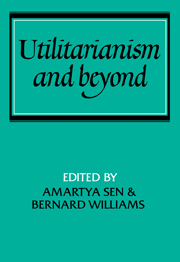Book contents
- Frontmatter
- Contents
- Preface
- Introduction: Utilitarianism and beyond
- 1 Ethical theory and utilitarianism
- 2 Morality and the theory of rational behaviour
- 3 The economic uses of utilitarianism
- 4 Utilitarianism, uncertainty and information
- 5 Contractualism and utilitarianism
- 6 The diversity of goods
- 7 Morality and convention
- 8 Social unity and primary goods
- 9 On some difficulties of the utilitarian economist
- 10 Utilitarianism, information and rights
- 11 Sour grapes – utilitarianism and the genesis of wants
- 12 Liberty and welfare
- 13 Under which descriptions?
- 14 What's the use of going to school?
- Bibliography
13 - Under which descriptions?
Published online by Cambridge University Press: 30 January 2010
- Frontmatter
- Contents
- Preface
- Introduction: Utilitarianism and beyond
- 1 Ethical theory and utilitarianism
- 2 Morality and the theory of rational behaviour
- 3 The economic uses of utilitarianism
- 4 Utilitarianism, uncertainty and information
- 5 Contractualism and utilitarianism
- 6 The diversity of goods
- 7 Morality and convention
- 8 Social unity and primary goods
- 9 On some difficulties of the utilitarian economist
- 10 Utilitarianism, information and rights
- 11 Sour grapes – utilitarianism and the genesis of wants
- 12 Liberty and welfare
- 13 Under which descriptions?
- 14 What's the use of going to school?
- Bibliography
Summary
The modern utilitarian has turned his back on his hedonist sources. His theory now takes in more than it did, and many of the old objections fail. But the current post-hedonism faces problems of its own. There is at least one central question it has no way of handling.
I will here speak of utilitarianism in its act-focussed form and will begin by assuming that its ethics is consequentialist. This is true of most versions of it, though (we shall see) not of all. The utilitarian, as this has him, holds two theses about right conduct. The first is that, wherever a person must act in one way or another, he should take some option whose consequences are at least as good as those of any alternative. The second thesis is that the better-or-worseness of the consequences is measured by the sums of the utilities people set on them.
The wording of the second thesis reflects the modern turn. None of the classical utilitarians spoke of utilities as being set. Utilities were to be enjoyed or pursued, for utility was simply pleasure or (for Bentham) ‘that property in any object whereby it tends to produce … pleasure’. The line of analysis more common today interprets utility in terms of preference – a person's total utility function numerically maps out his preference ranking. Preferences can be of any sort: I can prefer my having more pleasure to my having less, or prefer more pleasure for others to more pleasure for me, or prefer one thing to another where neither offers pleasure to anyone.
- Type
- Chapter
- Information
- Utilitarianism and Beyond , pp. 251 - 260Publisher: Cambridge University PressPrint publication year: 1982
- 4
- Cited by

